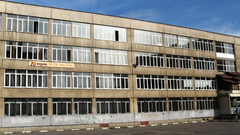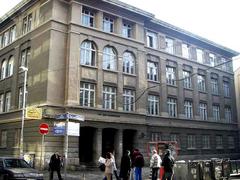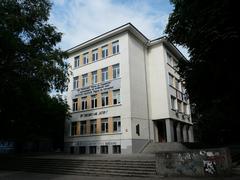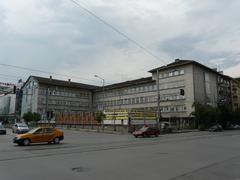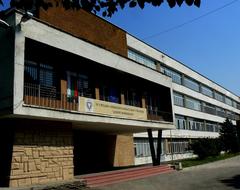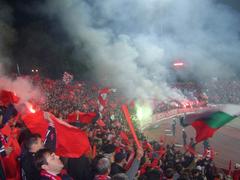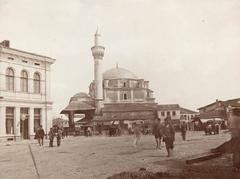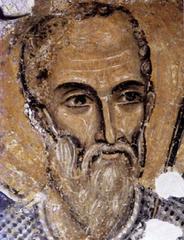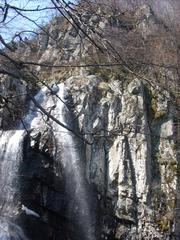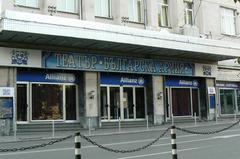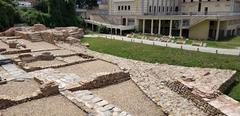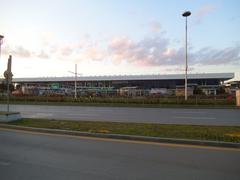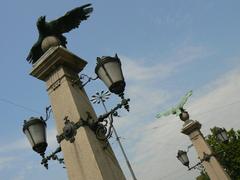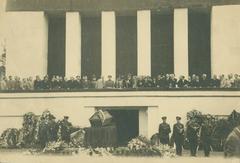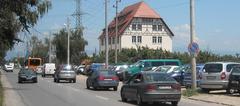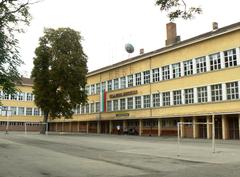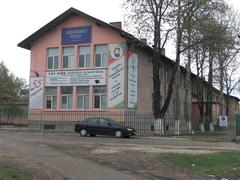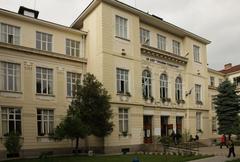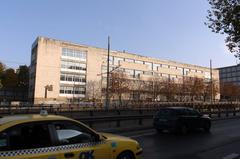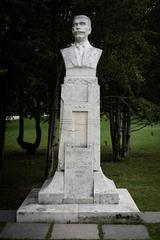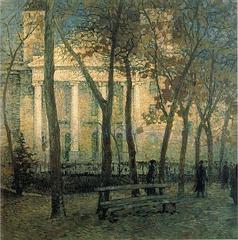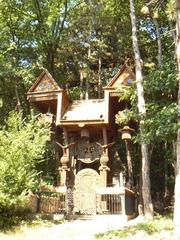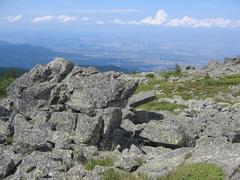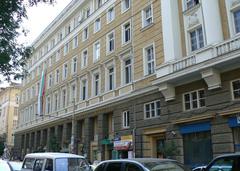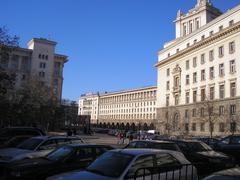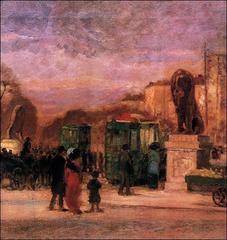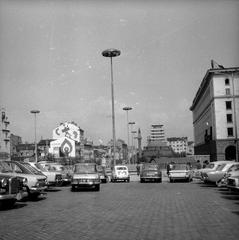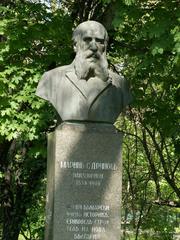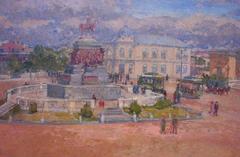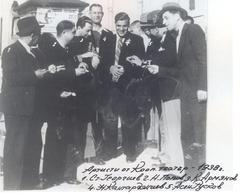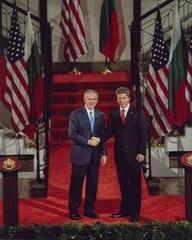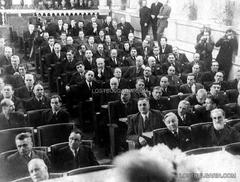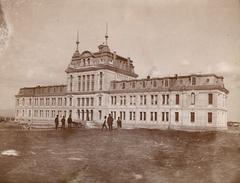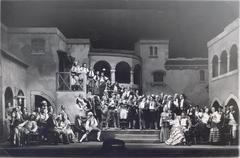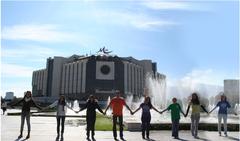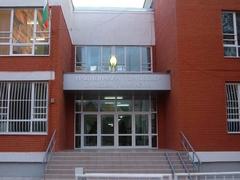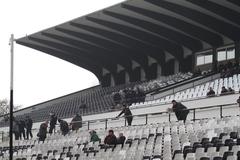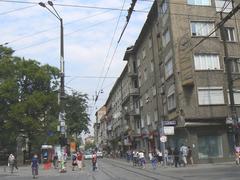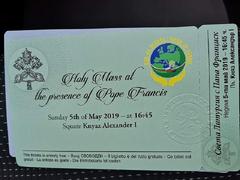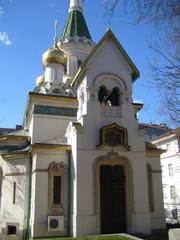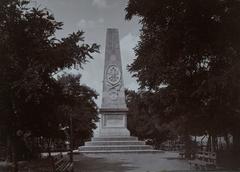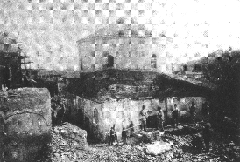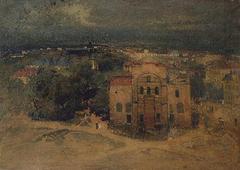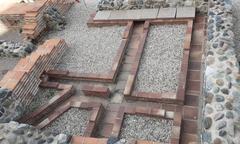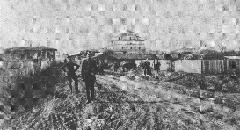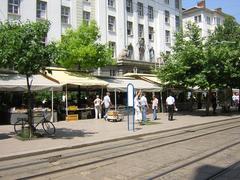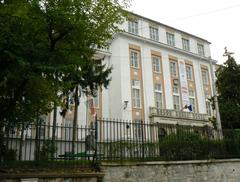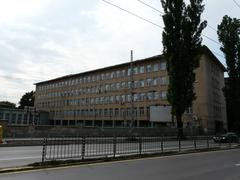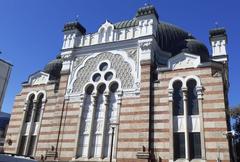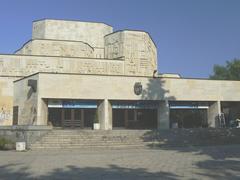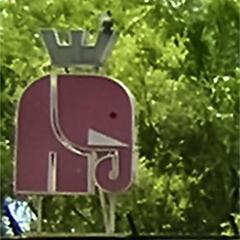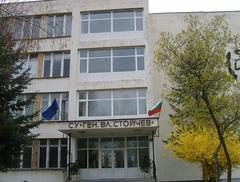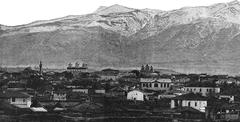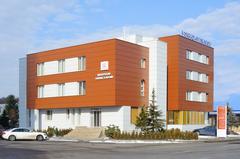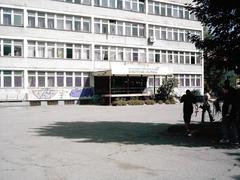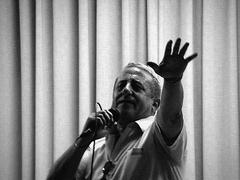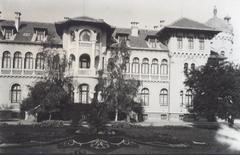
Sofia Public Mineral Baths Visiting Hours, Tickets, and Historical Sites Guide
Date: 04/07/2025
Introduction
Situated in the vibrant heart of Bulgaria’s capital, the Sofia Public Mineral Baths—also known as the Central Mineral Baths—stand as a remarkable emblem of Sofia’s rich historical tapestry and architectural grandeur. More than just a stunning building, the baths reflect a tradition of mineral water use dating back to ancient Thracian and Roman times, when the healing properties of Sofia’s mineral springs first attracted settlers. Over the centuries, the site has evolved through medieval, Ottoman, and modern eras, embodying the city’s cultural and social transformations (hiddenarchitecture.net; sofia.bg).
Built between 1905 and 1913, the baths exhibit a sophisticated blend of Neo-Byzantine, Vienna Secession (Art Nouveau), and Bulgarian national-romantic architectural styles. Renowned architects Petko Momchilov and Friedrich Grünanger designed the building, whose vibrant façade features colorful majolica tiles, intricate mosaics, and sculptural details celebrating health, water, and renewal (about-sofia.com; Cestee).
Public bathing operations ceased in 1986, but after extensive restoration, the building reopened in 2015 as the Sofia History Museum. Today, visitors can explore over 100,000 artifacts chronicling Sofia’s 8,000-year history, admire preserved architectural splendor, and enjoy collecting mineral water from public fountains outside (sofiahistorymuseum.bg; freesofiatour.com). The museum’s central location, accessibility, guided tours, and proximity to landmarks like the Alexander Nevsky Cathedral and Banya Bashi Mosque make it a must-visit site.
This guide provides detailed insights into the Sofia Public Mineral Baths’ history, architecture, cultural significance, practical visiting information—including hours and ticket prices—and tips for making the most of your visit (TripHobo; Audiala).
Table of Contents
- Introduction
- Ancient Origins and Roman Legacy
- Medieval and Ottoman Transformations
- Modernization and Central Mineral Bath Construction
- Social and Cultural Significance in the 20th Century
- Wartime Damage and Decline
- Restoration and Museum Transformation
- Architectural Style and Features
- Cultural Significance
- Visiting Sofia Central Mineral Baths
- Artistic and Decorative Elements
- Urban Context and Public Space
- Legacy and Recognition
- Regional History Museum of Sofia
- Sofia Mineral Springs Today
- FAQs
- Visuals and Media
- Conclusion
- References
Ancient Origins and Roman Legacy
The Sofia Public Mineral Baths’ story is deeply rooted in the city’s ancient past, with mineral springs drawing settlers since the 2nd millennium BCE (hiddenarchitecture.net). The Thracians first recognized the springs’ healing qualities, a tradition expanded by the Romans. During the Roman era, Sofia (then Serdica) became known for its thermal baths. The Romans constructed a grand bathing complex—the Thermae of Serdica—around the springs in the late 2nd century CE. Emperor Constantine the Great reputedly favored these baths, famously declaring, “Serdica is my Rome.” The baths served both hygienic and social purposes, establishing a tradition of communal bathing that persisted for centuries.
Medieval and Ottoman Transformations
With the decline of the Roman Empire, the mineral springs retained their centrality in urban life. In the Middle Ages, new bathhouses rose on the site, sustaining the tradition of communal gathering (sofia.bg). The Ottoman conquest in the 14th century introduced hamam (public bath) culture. The Ottomans built a bathhouse near Banya Bashi Mosque, reusing ancient infrastructure. This hamam became a daily social hub for centuries, remaining in use until the late 19th century when Bulgaria regained independence.
Modernization and the Central Mineral Bath
Following Sofia’s designation as Bulgaria’s capital in 1879, authorities sought to modernize the city and replace the decaying Ottoman bathhouse with a new, grand facility reflecting European aspirations (sofia.bg). In 1904, a design competition selected Petko Momchilov and Friedrich Grünanger’s proposal, merging Vienna Secession, Neo-Byzantine, and national-romantic styles (about-sofia.com). Construction took place from 1905–1913. The façade, adorned with multicolored majolica tiles, mosaics, and sculptures of Tyche and Apollo, became an instant landmark (nationalgeographic.com).
Social and Cultural Significance in the 20th Century
Opening in 1913, the Central Mineral Bath quickly became Sofia’s premier social hub (freesofiatour.com). Separate wings for men and women reflected contemporary customs. Bathing was both a hygienic and social activity—patrons would relax, converse, and enjoy refreshments. Specialized attendants (“telyatsi”) provided scrubbing services. The baths welcomed visitors from all social backgrounds, and the tradition of collecting mineral water from the fountains outside remains alive (bulgaria-infoguide.com).
Wartime Damage and Decline
The building survived World War II, though its southern wing was damaged (hiddenarchitecture.net). After repairs, it continued operating, but by the 1980s, private bathrooms in homes led to the baths’ decline. In 1986, poor maintenance and waning patronage forced closure (en.wikipedia.org; freesofiatour.com).
Restoration and Museum Transformation
Recognizing its significance, Sofia Municipality launched restoration efforts in the late 1990s (sofia.bg). The building was declared a national cultural monument in 1998, with the winning adaptive reuse project proposing its conversion into the Sofia History Museum (sofiahistorymuseum.bg). Restoration from 1998 to 2015 included roof repairs, majolica tile restoration, and new public fountains. The museum opened in 2015, featuring over 100,000 artifacts (freesofiatour.com; hiddenarchitecture.net).
Architectural Style and Features
Neo-Byzantine Grandeur
The building is a quintessential example of Neo-Byzantine architecture, with grand domes, ornate mosaics, and intricate tilework (Cestee). Its symmetrical plan features a central dome flanked by two smaller domes and a vibrant façade of glazed tiles in yellow, brown, and blue, highlighted by arches and friezes blending Orthodox and Ottoman influences. The interiors showcase marble columns, vaulted ceilings, and mosaic art, creating an atmosphere of opulence (TripHobo).
Structural Innovations
Early 20th-century engineering techniques, including reinforced concrete and steel frameworks, supported the large domes and masonry. Innovative piping systems ensured efficient management and delivery of mineral water.
Restoration and Preservation
Closed in 1986, the baths underwent extensive restoration, focusing on preserving the unique tiles, mosaics, and marble surfaces. Today, much of the original grandeur is visible, offering an authentic experience for visitors (Sofia History Museum).
Cultural Significance
Urban Identity and Multicultural Heritage
From Roman times through the Ottoman era, Sofia’s mineral springs shaped the city’s reputation as a spa destination (Cestee). The Central Mineral Baths’ construction marked Bulgaria’s modernization and national revival, blending Ottoman and European influences. Its architecture—merging Byzantine, Ottoman, and Bulgarian Revival styles—symbolizes Sofia’s multicultural heritage (TripHobo).
Contemporary Role
Now home to the Sofia History Museum, the baths host exhibitions tracing the city’s evolution from antiquity to the present (Sofia History Museum). Temporary exhibits, cultural events, and workshops maintain its role as a community center. The surrounding park and mineral fountains remain popular gathering spots.
Visiting Sofia Central Mineral Baths
Visiting Hours
- Tuesday–Sunday: 10:00 AM–6:00 PM
- Closed Mondays
- Check the official Sofia History Museum website for seasonal changes and holiday closures.
Tickets and Guided Tours
- General admission: 6 BGN
- Reduced (students, seniors): 3 BGN
- Free for children under 7 and Bulgarian citizens on select holidays
- Guided tours available upon request; book via the website or onsite.
Accessibility and Facilities
The museum is fully wheelchair accessible, with ramps and elevators. Guided tours in multiple languages and educational workshops are regularly available.
Nearby Attractions and Travel Tips
Located at 1 Banski Square, the baths are close to:
- Banya Bashi Mosque
- Central Market Hall
- Ivan Vazov National Theatre
Combine your visit with these sites for a comprehensive historical experience (Trek Zone).
Travel tip: Visit on weekday mornings for fewer crowds, and bring a reusable bottle to sample mineral water from the fountains outside.
Artistic and Decorative Elements
Mosaics and Tilework
The baths feature extensive mosaics and decorative tiles with motifs inspired by Bulgarian folklore and mythology (Cestee). The exterior ceramic tiles, crafted by Bulgarian artisans, display vibrant colors and geometric designs.
Sculptural Details
Reliefs and statues, including allegorical figures of health and rejuvenation, reinforce the baths’ healing purpose and showcase the craftsmanship of the era.
Urban Context and Public Space
The baths’ central location ensures accessibility by public transport, and the landscaped park and mineral water fountains serve as vibrant community spaces (TripHobo).
Legacy and Recognition
The Sofia Public Mineral Baths influenced Bulgarian architecture by merging tradition and modernity. Declared a cultural monument of national significance, the building is protected and maintained for future generations (Cestee).
Regional History Museum of Sofia
Layout, Exhibitions, and Services
The museum’s permanent exhibition spans eight thematic halls, covering Sofia’s development from the 6th millennium BCE to the 1940s and featuring over 100,000 artifacts (About Sofia). Highlights include Roman mosaics, medieval icons, royal memorabilia, recreated urban scenes, and artifacts from the city’s multicultural past.
Interactive exhibits, workshops, and family-friendly programs make the museum engaging for visitors of all ages (Audiala). Full accessibility is ensured with ramps, elevators, and adapted facilities (Visit Sofia).
Visiting Hours and Tickets
- Winter (Oct–Apr): Tue–Sun 10:00–18:00
- Summer (May–Sep): Tue–Thu 11:00–19:00, Fri 12:00–20:00, Sat–Sun 11:00–19:00
- Closed Mondays
Tickets:
- Adults: 10 BGN
- Students/Seniors: 5 BGN
- Free for children under 7, and on select dates (Audiala; Sofia History Museum)
Location and Branches
Located at 1 Banski Square, the museum is within easy reach of major landmarks and public transport (Visit Sofia). Additional branches include the Underground Museum at the Basilica of Saint Sofia, the Tomb of Prince Alexander I, and the Exposition for National Reconciliation (About Sofia).
Sofia Mineral Springs Today
Legacy and Experience
Sofia remains one of the world’s most mineral-rich capitals, with 75 hot springs across the city. While public bathing at the Central Baths is no longer available, visitors can enjoy mineral water from the public fountains. Neighborhoods like Knyazhevo, Gorna Banya, and Ovcha Kupel feature additional springs, some with spa facilities.
Special Events and Tours
Guided walking tours focusing on mineral springs and historical bathhouses are available, often including visits to the Central Baths and Serdica archaeological sites. Check local tourism resources for event updates.
Sustainable Tourism and Future Plans
Efforts to restore historic baths and sustainably develop Sofia’s mineral resources continue, balancing heritage preservation with modern urban needs.
Frequently Asked Questions (FAQ)
Q: What are the Sofia Public Mineral Baths visiting hours?
A: Tuesday–Sunday, 10:00–18:00. Closed Mondays. See the official website for updates.
Q: How much are tickets?
A: General admission is 6–10 BGN; discounts for students and seniors; free on select days.
Q: Are guided tours available?
A: Yes, book via the website or onsite.
Q: Is the museum accessible?
A: Yes, with ramps and elevators.
Q: Can I collect mineral water?
A: Yes, from the public fountains outside.
Q: What other attractions are nearby?
A: Banya Bashi Mosque, Central Market Hall, Ivan Vazov National Theatre.
Visuals and Media
Explore virtual tours and high-quality images on the Sofia History Museum website. Suggested image alt text:
- “Sofia Public Mineral Baths colorful façade”
- “Interior cast iron details at Sofia Central Mineral Baths”
- “Public mineral water fountains at Sofia Central Mineral Baths”
Conclusion
The Sofia Public Mineral Baths are a living monument to Sofia’s layered history, blending natural heritage, architectural artistry, and centuries-old social traditions. From ancient origins to modern museum, the baths embody the city’s resilience and cultural pride. Visitors can immerse themselves in the museum’s exhibitions and living traditions, enriched by accessible facilities, guided tours, and proximity to key landmarks.
For the latest information on hours, tickets, and events, visit the official Sofia History Museum website and consider the Audiala app for enhanced tours. Experience the enduring legacy of Sofia’s mineral springs and discover a unique cultural gem at the heart of Bulgaria’s capital.
References
- This is a sample text. (hiddenarchitecture.net)
- This is a sample text. (sofia.bg)
- This is a sample text. (about-sofia.com)
- This is a sample text. (Cestee)
- This is a sample text. (sofiahistorymuseum.bg)
- This is a sample text. (freesofiatour.com)
- This is a sample text. (bulgaria-infoguide.com)
- This is a sample text. (Audiala)
- This is a sample text. (Visit Sofia)
- This is a sample text. (TripHobo)

